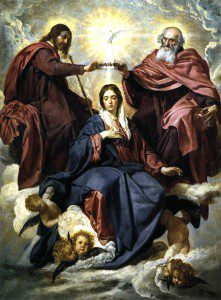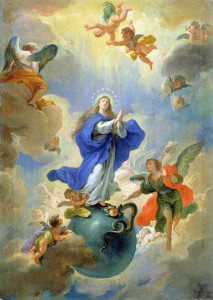In a recent post, I looked at the mysterious figure of the “Woman clothed with the Sun,” depicted in the Book of Revelation. I suggested that she was likely to symbolize New Israel or the Church, although later generations have usually connected her with the Virgin Mary, and the Revelation passage has largely shaped later iconography of the Virgin as Queen of Heaven.
I do not mean to suggest, though, that the Marian interpretation was a simple pious blunder. What I am arguing is this:
*In the earliest Christian writings, the Epistles and Mark’s gospel, Mary scarcely appears, and certainly not in any leadership role.
*Towards the end of the first century, Mary’s role becomes vastly more important, most dramatically in Luke-Acts. The Magnificat in Luke 1 is a prime example.
*No later than the mid-second century, devotion to Mary is so intense as to inspire major apocryphal writings like the Protevangelium, which present her almost as a parallel Christ figure. Early Fathers like Justin Martyr and Irenaeus are writing about Mary as a kind of anti-Eve, who reverses the Fall. In the medieval Latin world, Eva brought the Fall, which was reversed in Ave – Ave Maria!
So why do we have this process of exaltation, which begins relatively late, but which then takes off at amazing speed between say 90 and 150?
Here’s a suggestion. In the later first century, Christians are already symbolizing New Israel as a heavenly female figure, as evidenced most clearly in Revelation. We also see there the idea that in a symbolic way, she is the mother of the Messiah. It’s not a huge leap from there to identify that female figure with the specific woman who actually was Jesus’s mother.
What I am wondering is whether that emerging idea shaped Luke’s portrayal of Mary in his writings. I don’t suggest that Luke knew Revelation, or that the author of Revelation knew Luke’s writings. Rather, both existed in a common early Christian world in which that imagery, that symbolism and rhetoric, was becoming familiar.
In other words, something like the Magnificat is already deliberately intended to represent the words of Israel as a collective or symbolic entity, rather than just the human Mary. Of course, that text also draws heavily on the Old Testament Song of Hannah in 1 Samuel 2-10, but there’s more going on.
So perhaps the vision of the Church/New Israel shapes the image of Mary, who is subsequently understood as the Mother of the Church. We come full circle.














